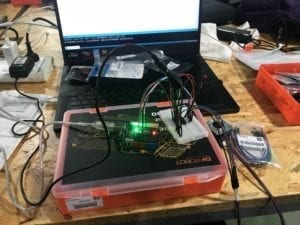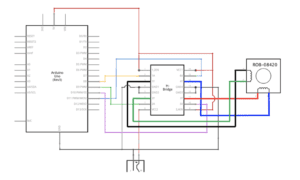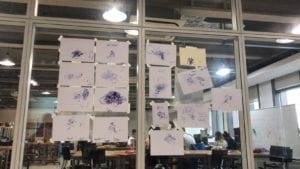Motors:the Stepper
Today we come to know the use of a new motor which is called the “stepper”. As its name, it moves at an accuracy of step, and due to that charateristic, it is widely used in many aspects of our daily life.
In this recitation we will use the stepper to build a drawing machine.
Step 1: Build the circuit

 (the circuit)
(the circuit)
The circuit wasn’t hard to build and when the stepper rotated i found that unlike a DC mortor, the stepper can reverse its direction by itself without changing the outer current.
Step 2: Control rotation with a potentiometer
The stepper shaked and stopped shaking when potentiometer was at some certain points. I first guessed that it was because that the input was not a integer so the stepper might have some problem reading it. However, i’m told that it was functioning properly and the shaking is quite normal.
Step 3: Build a Drawing Machine!

The pen was actually not long enough, so we think a lot to compensate that deficiency, including using something beneath to make the paper higher and loosening the nails to lower the position of pen. Finally, after many failures, we succeeded in producing a painting with our drawing machine.
Q&A Part
Queation 1:
I’d like to create a machine which can walk itself by the force of nature. I’m inspired by the “Strandbeast” created by Theo Jansen which facinates me a lot. The actuators are the core of machine and almost every movement is powered or controlled by them, but the strandbeasts’ actuators are just some PVC pipes, which is the most unique part of it and reminds us of how complicated things some small mindless things can do by working together. In its design, i think if we use the digital manipulation tools, things will get much easier as we can stimulate the movement and structure on computers first. And, finally, yes. The process requires a lot of creativity and if possible should better be done with a group of people brainstorming together about its moving structure, walking components, path finding components and its power source. There are also many problems that designers may face, like weight, physical endurance, ability to handle emergencies (like encountering an obstacle) and these can only be solved with wit and innovation.
Queation 2:
The Mechanical Mirrors: Wooden Mirror impressed me a lot. Some wooden pixie painted with differnt shades can make a complete picture, but it’s still the faithful reflection of the reality world and our work, though simple, is a kind of creation, reflection of humans’ uncertain inner part. That’s the greatest difference. And considering that it may require percise rotation at the accuracy of angle, i think that the creator may have chosen to use the servo motors as actuators for his project